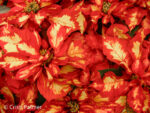This first appeared as “Spotlight on Ornamentals: Poinsettia” in the IR-4 Newsletter 39(4):2.

Native to Central America, poinsettia (Euphorbia pulcherrima) has become one the the most beloved holiday plants in the United States. With dramatic red bracts and crisp dark green leaves, poinsettia cheers us as the days grow colder and shorter. This plant has come to represent festive, joyful times as we celebrate our ties to family and friends. Would December still feel as merry without poinsettias prominently displayed in our homes and businesses? Americans can choose from among dozens of varieties to raise our holiday spirits, and they do, with holiday poinsettia purchases totaling more than $250 million annually.
A Brief History

Euphorbia pulcherrima, originating in the Taxco del Alarcon region of Southern Mexico, was used by the Aztecs as a source of purplish dye for textiles and cosmetics as well as for the base for a medicine to treat fever. This plant may have remained in obscurity if it had not been noticed by Joel Roberts Poinsett (1779-1851), the first United States Ambassador to Mexico. During a visit to Taxco del Alarcon in 1828, Poinsett became intrigued by the bright red bracts brilliantly displayed during the short days of winter. Although Poinsett had attended medical school to follow in this father’s footsteps, he developed a deep interest in botany. His passion led him to eventually found the institution we now call the Smithsonian Institute. It also led him to collect E. pulcherrima during 1828 and take this unique plant home to his plantation in Greenville, South Carolina. Poinsett propagated from his collection to share with friends and botanical gardens. This plant has subsequently been dubbed the “poinsettia” in the United States and most of the English-speaking world to honor Joel Robert Poinsett.
Breeding and Production

During the last 180 years, horticulturalists and breeders have developed new varieties with special characteristics. Beyond the traditional red, colors now include white, cream, and pink in solids and various speckles and patterns. Bract shape has developed over time from a simple leaf shape to twists and ruffling. One of the most desirable traits discovered early last century – enhanced branching after pitching – is now known to be caused by a phytoplasma.
Even with all the breeding programs to develop new colors or forms, production practices are still rooted where poinsettias originated. Poinsettia plants require special production methods to encourage the bracts to change color in time for holiday cheer. Growers must provide shorter days by drawing black cloth over the plants to simulate a longer period of darkness. Even a small flash of light during the night can inhibit the transformation.
IR-4 Research
Of the various diseases and pests affecting poinsettia during production, the IR-4 Project has worked to develop efficacy information on some key problems. For Phytophthora and Pythium root rots, newer products like Fenstop and Segway were compared to the standard Stature and Subdue MAXX in order to develop data to support labels. For Q whiteflies, IR-4 screened 35 products, including Judo and Safari, contributing significantly to the information used to create a Whitefly Management Plan for ornamental production.
With the IR-4 research efforts, United States growers will continue to have healthy crops, so we call can continue to brighten our holidays with cheerful, live poinsettia displays.
More Information on Poinsettias from University of Illinois Extension
Anatomy of a Poinsettia
The showy colored parts of Poinsettias that most people think of as the flowers are actually colored bracts (modified leaves). The yellow flowers, or cyathia, are in the center of the colorful bracts. The plant drops its bracts and leaves soon after those flowers shed their pollen. For the longest-lasting Poinsettias, choose plants with little or no yellow pollen showing. The color of the bracts are created through “photoperiodism,” meaning that they require darkness (12 hours at a time for at least five days in a row) to change color. On the other hand, once Poinsettias finish that process, the plants require abundant light during the day for the brightest color.
Many plants in the Euphorbiaceae family ooze a milky sap. Some people with latex allergies have had skin reactions after touching the leaves.
Despite rumors to the contrary, Poinsettias are not poisonous. A study at the Ohio State University showed that a 50-pound child would have to eat more than a pound and a quarter of Poinsettia leaves (500-600 leaves) to have any side effects. The most common side effects that have been reported from Poinsettia ingestion are upset stomach and vomiting.
In nature, Poinsettias are perennial flowering shrubs that were once considered weeds. Poinsettias are not frost-tolerant. They will grow in outdoors in temperate coastal climates, such as Southern California beach communities. In the group, they can reach 10 feet tall.
Poinsettias by the Numbers
There are over 100 varieties of Poinsettias available today. Though once only available in red, there are now Poinsettias in pink, white, yellow, purple, salmon and multi-colored. The red Poinsettia still dominates over other hybrid color options. “Prestige Red” – one of the many poinsettias patented by Ecke – ranks amount the best selling hybrids.
Poinsettias contribute over $250 million to the U.S. economy at the retail level annually with California being the top Poinsettia producing state in the country. Poinsettias are the best selling potted plant in the United States and Canada, especially during Christmas and the winter holiday season.
Sources Cited
http://www.pauleckepoinsettias.com/html/hist_fset.html


